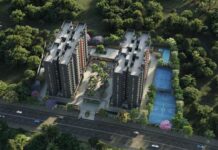New Delhi, May 06, 2018: Still developing, India has been witnessing a high rate of inter-state migration in the recent years. Evidently, the shift is from rural to the urban regions.
The urban centres of the country have been pulling in the rural population for offering several modem facilities. Amongst the chief metropolitan cities, Delhi, Mumbai and Kolkata are the most opted cities for offering a better lifestyle. On the other hand, Bengaluru, Hyderabad and Pune are emerging as IT hubs, mainly attracting people for employment in this sector.
Besides improving the living standards of the people, the growing rural-urban convergence has created a pressure on land in the major cities of the country. Showing its stress on the housing industry, migration has led to an emergence of a concept of ‘housing for all’.
The government of India initiated a flagship programme, the Pradhan MantriAwasYojana (PMAY), to ensure the availability of pucca houses, comprising of all the basic amenities. The aim of the programme is to ensure a better lifestyle for the population currently residing in shanties and shabby structures. Under the programme, costs of buying a house has significantly reduced. Moreover, the possibilities of homeownership to a greater number of individuals and families have relatively expanded.
Besides ensuring houses for all, the government has implemented several policies and new amendments in the past two years to create transparency in the real estate market. These include Real Estate Regulatory Act (RERA), Real Estate Investment trust (REIT), Goods and Services Tax (GST) and demonetization.
The increasing stress on the housing market also led to the expansion of cities to the outskirts. Whereas Delhi extended its boundaries to areas like Gurgaon, Noida, Faridabad and Ghaziabad, the realty market of Mumbai moved towards locations like Navi Mumbai, Thane and Dombivli.
Contributing significantly to this trend, Delhi-based realtors like DLF, Earth Infrastructure, and Raheja Developers have been setting up houses in the suburbs inclusive of all amenities. On the other hand, realtors in Mumbai like Hiranandani Developers, K Raheja Corp, and Kalpataru Group have been expanding their construction activities in the satellite cities and outskirts.
A self-regulatory body, the National Real Estate Development Council (NAREDCO) also came up with an aim to promote transparency and bring affordability in the realty sector. The body functions under the supervision of Ministry of Housing and Urban Poverty Alleviation, Government of India.
Established in 1998, NAREDCO acts as a single platform for the resolution of various issues of the sector. It strives to transform the unorganized Indian realty market into a globally competitive sector.
Dr NiranjanHiranandani, who recently took over as the National President of NAREDCO, assured that the association would provide all support and abide by the mission of ‘Housing For All by 2022’.
He said, “NAREDCO will work to help redefine the parameters of the Indian real estate, given the transformation and reformatory steps taken by the government.”
In September 2013, a separate branch of the National Real Estate Development Council came to be known as NAREDCO West, was established in Mumbai. Representing the real estate sector of western India, the council is dedicated towards creating a responsive real estate property environment.
NAREDCO West is currently operating under the recently elected President, Neel Raheja, the Group President of K Raheja Corp. Since then, he has been actively participating in the redressal of issues related to housing and real estate sector.
Changes in the real estate sector in Mumbai has also brought comments and statements from real estate pioneers.Earlier at his appointment as the NAREDCO president, Neel Raheja shared his thoughts and stated, “NAREDCO West has always been at the forefront of addressing issues faced by the industry. It is with a sense of pride and humility that I accept this august position.”
“I assure my fellow industry members that in keeping with the theme of 2017, we will strive to ensure that Ease of Doing Business in India quotient takes a significant leap forward. We also endeavour to work closely with the government for enhanced development of the sector,” he added.
In the past few years, the Indian government has been initiating various policies to improve the real estate sector. Moreover, it has also set a target to achieve ‘housing for all by 2022’. With different bodies and policies working in same direction, the sector is likely to flourish in the upcoming years.
Corporate Comm India(CCI Newswire)



















